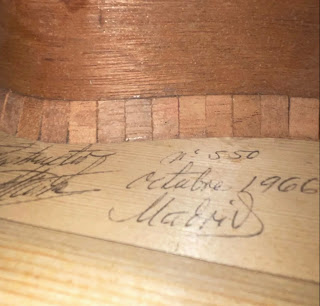This Andres Martin guitar I was able to buy on an auction and
though I really have enough guitars, this one I could.nt resist
with its' beautiful old school sound. some reparations were
needed but the superior inlay work on both the rosette and
the sides are betraying superior workmanship.
You can click on this picture to study this meticulous made
rosette on this flamenco ment guitar. From 1960 (Madrid)
His typical headform though a bit vulnerable to
damages to my opinion. Andres Martin often is
confused with the Valencia based Andres Marin.
The back of the head that is carrying the typical
early sixties Fustero tuners of the past age.
the cypress back with one well repaired crack in the
lower bout on the right.
As can be expected a light guitar with a beautiful
resonance. Andres Martin learned from Santos
Hernandez and Marcelo Barbero not the least in
the luthier world of Madrid.
The body on the front that also has a well repaired crack.
I'm not that afraid buying guitars with cracks as a good
repaired guitar brings it back to its' former glory.
The Label here that has been hand signed and moreover
also the inner soundboard has been signed and dated.
It says number 275 - 1960.
A good picture of a later signed Andres Martin guitar that
shows us the way Andres Martin signed his soundboards.
Mirecourt guitar
but thoughts are that it could be a Nicolas Morlot,
a luthier who also built good violins. Well known is
the Chevron type inlay. The bridge is a later addition
to my believe as the model is not similar to other
bridges on instruments of that time.
back: Apparently Cuban mahogany. Mahogany is also widely
used for fine furniture: However, the rarity of Cuban mahogany
and over harvesting of Honduras and Brazilian mahogany has
diminished their use. This typical wood is prone to cracking
however. This instrument is in good though not original
condition. It has a sweet and even voice over the different
strings. The inside of the soundbox has been veneered with
spruce as was quite common at that time.
bit of what was conventional, though the "Eight"
model was well known. Veneered with ebony.
used for the sides of this nice instrument.
ANONYMOUS MIRECOURT GUITAR (1825).
 This instrument hasn't got a lot of decorations.
This instrument hasn't got a lot of decorations.The soundboard apparently hasn't even been quarter sawn
being a sign of some cheapiness. After restoration this
guitar appears to be a very well balanced sounding
instrument with a nice and sweet voice.

This picture clearly shows the ivory frets while ebony has been
used for the highest frets. Note that fingerboard and
soundboard are in one line as was done up untill 1835.
used for the highest frets. Note that fingerboard and
soundboard are in one line as was done up untill 1835.

These heels are quite common on french made guitars
of that period. This particular instrument has a wooden
binding on the back.

The back of this Mirecourt guitar has been veneered
with a kind of mahogany on spruce. The neck has been
veneered with ebony. Violinlike pegs are used for tuners.
















Geen opmerkingen:
Een reactie posten